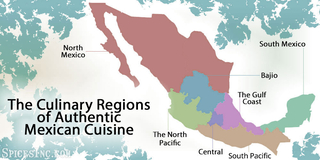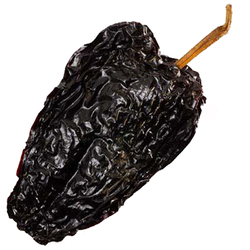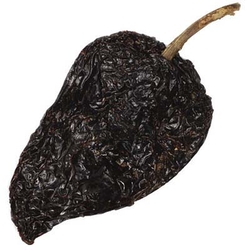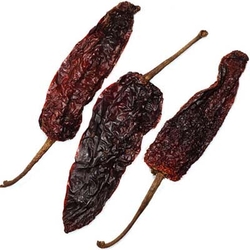The Culinary Regions of Authentic Mexican Cuisine
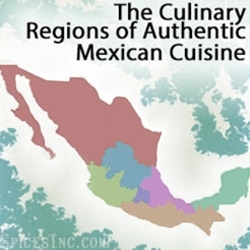
When we talk about Mexican food in the US, the conversation inevitably turns to tacos. Yes, they are delicious, perfect little crunchy packages of savory fillings that offer up hits of cheese and spiky salsa, but Mexican cuisine is so much more than just tacos. There are seven distinct regions in Mexico that contribute to the overall concept of Mexican cuisine, each with their own history and story to tell. The foods of Mexico, a country that is home to over 125 million people, are as unique as the people that live there.
Looking more deeply into Mexican cuisine, we find characteristics that make each of these seven regions special. And while there are differences between the regions, Mexican food across the country generally places an emphasis on fresh, natural ingredients that are locally sourced. Chiles are plentiful, whether the tortillas are corn or wheat, you’ll often find them hand-made, and the food exudes the sort of warmth and welcome that tastes like an abuelita's love.
The North
Known as El Norte in Spanish, The North is the largest culinary region in Mexico. It stretches for 2,000 miles, from Baja California’s Pacific coast to the Gulf of Mexico, just below Texas’s southernmost tip. This is ranch country, so the food is centered around ranch life, and grilled beef is a favorite dish in El Norte. Because of the predominance of cattle ranching, you can also find a strong dairy culture in The North that produces popular cheeses like the feta-esque farmer’s cheese queso fresco or tangy, salty, ricotta-like requesón. Wheat burritos are popular in The North, and despite popular opinion that burritos come from Texas, they were created in Sonora, the Mexican state that sits directly below Arizona. Baja California, at the western edge of El Norte, is home to Mexico’s oldest wineries, and produces classic varietals like Cabernet Sauvignon, Chardonnay, and Malbec.
Some of the most popular foods include the spicy ceviche dish called guacavaqui; machaca, or shredded jerky; the much beloved Burritos; and the grilled skirt steak specialty, Carne Asada.
The North Pacific Coast
The North Pacific region is also known as the breadbasket of Mexico, since much of the country's produce comes from this region. You’ll find an abundance of grain, fruits, vegetables, of course, chiles. With roughly 900 miles of coastline that stretches down from the southern end of the Bay of Cortez, seafood is an incredibly important food from this region. The Mexican state Jalisco, with its motto “Jalisco is Mexico”, has tremendous culinary impact on this region. Not only is Jalisco home to several classic Mexican dishes, it is also the region from which tequila comes. This legally protected beverage can only be produced in select regions around Jalisco, roughly 40 miles north of Guadalajara. The capital city, Guadalajara, is the gastronomic center of the North Pacific region.
Some of the most popular foods include fish tacos, aguachile—a sort of ceviche marinated with chiles—and menudo. The most famous dish of the region is Birria, a hearty, simmered stew that is made with beef or pork and plenty of chiles and spices. Birria gave rise to Quesabirria Tacos, a hearty and fun taco that made its way from Jalisco to Tijuana, in El Norte, before coming across to the US.
The Bajio
The Bahio stretches from a small, Pacific coastal border to a central, inland plateau surrounded by mountains. This was one of the first regions that the Spaniards colonized, since they liked the geography and felt that it resembled their homeland. This region sees plenty of Spanish influence in its foods, as the Spaniards were the ones who introduced things like pork and rice to Mexican cuisine. Michoacan is the state in the Bahio that meets the coast, and it grows upwards to 92% of the entire country’s crop of avocados. Cotija cheese, a crumbly, salty finishing cheese from the town of Cotija, is Mexico’s version of parmesan and adds an unmistakable, briny tang. You’ll find a popular alcoholic drink called charanada, which is made from fermented corn. This region is especially popular for sweets and desserts like cajeta, Mexico’s answer to dulce de leche, a caramel made with goat's milk.
Some of the most popular foods include the sausage and rice dish, morisquestas, and delicious fried pork carnitas. Arroz con leche, or rice pudding, is a Bahio specialty. This region is often credited with the origin of Pozole Rojo, a pork and hominy stew that dates back to the Aztecs.
The South Pacific Coast
The South Pacific Coast of Mexico is riddled with complexity. This region runs for roughly 900 miles along the Pacific Ocean and is home to popular resort towns like Acapulco, but builds eastward into a rugged and sparsely populated mountain region, which retains and protects many of its indigenous traditions and foods. Oaxaca has been called “The Land of the Seven Moles”, and there is evidence that these thick sauces have been a part of the South Pacific Coast culinary scene since the Aztecs. Oaxacan cheese is a mild, stretchy cheese that’s been compared to mozzarella. Blandas, large corn tortillas, are found in this region, and serve as the traditional base for Tlayudas, a pizza-like dish made with black beans and Pasilla de Oaxaca chiles.
Some of the most popular foods include enfrijoladas, or enchiladas covered in black bean sauce, and Tamales, which have been a part of the Mexican culinary landscape since the Mayan civilization which first came into being in 2000 B.C. You can also find Mayan Hot Chocolate there and enjoy it with, or without, the alcohol spike.
The South
This region sets itself apart from the rest of Mexican cuisine because of its tendency to fuse Mexican and Caribbean ingredients. Foods from the South often incorporate something sweet and tart, like orange or tamarind, with savory elements like roasted or grilled meats and smoke. Annatto, or Achiote seeds are used in abundance in this region, giving food a beautiful red color and mild, peppery flavor. The south is also famous for the salsas that it produces; you’ll find chiltomate, a cooked salsa made with tomatoes and habaneros, everywhere in the South.
Some of the most popular foods include poc-chuc, a simple grilled pork that’s been marinated in citrus, and coconut shrimp. Enjoy the spicy, Caribbean-fusion sweetness of Pineapple-Habanero Salsa. Pibil, a slow-roasted dish made with pork or chicken, is arguably the South’s most famous dish.
The Gulf
The Gulf region of Mexico is made up of two states, Veracruz and Tabasco and yes, Tabasco is the birthplace of that famous, spicy sauce. Cuisine from the states that border the Gulf of Mexico is a terrific blend of Mexican, Caribbean, and African influences. Chile peppers can be found working in harmony with plantains, yucca, or sweet potatoes. Vanilla, a notoriously temperamental orchid to grow, is indigenous to this region. Since it’s adjacent to the Gulf of Mexico, seafood is also popular here and huachinanga a la Veracruzana, or red snapper in a spicy, tomato-ey Veracruz-style salsa, is a definitive dish of this area.
Some of the most popular foods include garnachas, or thick corn patties topped with beans, cabbage, and cheese, and arroz a la tumbada, a dish made from fresh seafood and rice. Afro-fusion can be enjoyed with Red Chile Steak with Plantains, and get a taste of Veracruzana style with a vegetarian version of this classic dish.
Central Mexico
Central Mexico is home to Mexico City and as a result, showcases an array of traditional, regional dishes, influences from around the world, and an ever-changing landscape of street food. Tortas are a type of sandwich filled with refried beans, chicken, pork, or just about anything else you’d like. The Mexican street corn, elote, is dressed with butter or mayonnaise, cheese, and a special seasoning, and can be found as a cob you can carry and eat or as a salad in a to-go cup. Mole poblano, from nearby Puebla, is widely considered to be Mexico’s national dish. This is named for its use of the poblano chile, a locally grown pepper that’s also famously stuffed and fried for Chile Rellenos. When it is fresh this chile is called the poblano, but when it is ripened until it turns red and then dried, it is called an Ancho. When it’s allowed to continue to ripen to full, dark brown maturity, it's called a Mulato.
Some of the most popular foods include Barbacoa, which comes from the central highlands but can be found all over Central Mexico, and the internationally beloved Mole Poblano. Elotes and tacos can be found at food trucks and restaurants, or try the long-simmering Puebla specialty, Chicken Tinga.
Mexico has an enormous array of foods that embody the history and vibrancy of the regions in that country. While we can always make room for tacos and they’re always welcome on the table, there’s also plenty of space for something unexpected, new to you, regionally interesting, and wholly, deliciously Mexican.

